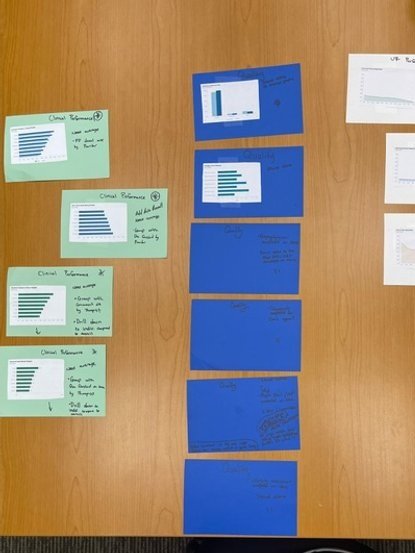Behavioral Health CareChain
Behavior Health CareChain is a nursing application that integrates with electronic medical records to organize clinical data, documentation, nurse schedules, and performance reports within the utilization review (UR) process.
ARGO Data
Role • Product Designer
Timeline • 1.5 years
Tools • Figma, Figjam, Azure DevOps
Platform • Browser application for desktop and tablet
Discover
Behavioral Healthcare Problems
Behavioral health has been one of the most problematic areas in healthcare for many reasons:
Rising numbers in depressive and anxiety disorders.
Behavioral health facilities are losing revenue due to denials from insurance companies.
Denial rates are high due to lack of quality documentation prepared in time for reviews.
Nurses rely on EMR systems and paperwork/documentation from multiple parties which easily gets unorganized and often times incomplete.
Nurses are overworked and facilities are understaffed due to revenue loss from high denial rates.
Discover
Objective
The main purpose is to decrease insurance reimbursement denial rates for in-patients in acute care within the utilization review (UR) process. Some other goals include increase the efficiency of UR Nurses day to day tasks, reduce errors in documentation, reduces missed deadlines, and increase staff accountability.
Define
Understanding our users
Executives
CEO
CFO
UR Supervisors
UR Nurses
Staff Nurses
Clinical staff
Therapists
Doctors
System administrators
Quality assurance
Define
Let’s focus on one user in particular
You can consider UR Nurse Betty our “power user”. Understanding a UR Nurse’s day at work can be large pill to swallow. Our objective is to automate, organize, and efficiently aid Nurse Betty with her tasks so that she can properly tend to her patients and get her patient stays approved through their insurance companies.
Define
Journey Map - UR Nurse
A day in the life of a UR Nurse.
Define
The Utilization Review process
Four potential stages of reviews:
Initial authorization
Concurrent review
Peer to peer review
Final appeal
Define
Gathering requirements
Two former UR nurses and a nursing director served as the product team to create their first healthcare application. As a designer, this was my first experience with any healthcare product so this gave us all an opportunity to learn and merge the two industries.
Define
Sitemap
Creating a sitemap helped inventory the application and provide the ability to look at the information architecture from a bird’s eye view.
Design
Workshops
Workshops help everyone visualize and normalize solutions, propels design decisions, and keeps everyone on the same page before designs are delivered. Here’s a few examples of workshops performed with stakeholders and subject matter experts:
Sketching
Whiteboard
Card sorting
A/B testing
Design
Sketching
Sketching is so important because in the beginning. It keeps everyone on the same page and it starts painting a picture. Not to mention it’s a very cheap and efficient.
Design
Low fidelity
Once the main screens are sketched out and everyone comes to consensus on the design direction I hopped right into low fidelity designs. Again, cheap and easy. This helps avoid going in the wrong direction before designs appear to be more “final”.
Design
Messy ideas
Throughout the early stages of this project I was pressed to deliver conceptual designs earlier than I anticipated. Without any requirements, a lot of the first stage of requirements were based off of Figma designs from a few key screens such as the patient census, schedule, and summary which later drove other features.
Design
User Roles and Permissions
After establishing and mapping all of the permissions for each role it came time to reflect these permissions within the UI. My approach was simple yet effective for developers. Essentially, in Figma I sectioned off each role and included the screens and actions that are permitted to each role with notes listing out the permissions for each.
Deliver
Patient Census
A database of assigned in-care patients serves as the landing page for UR nurses. This provides a quick glance at important patient data such as diagnosis, insurance provider, admission date, scheduled call date, and so on. This table is sorted by scheduled call dates which improves workflow by providing a sense of urgency.
Deliver
Schedule
The schedule organizes UR staff’s calls, appointments, and days off. It’s automated to adjust and properly schedule out insurance calls according to deadlines and availability.
Deliver
Patient Summary
Any documentation recorded for a patient would be pulled from the electronic medical records and stored in the patient summary screen using HL7 fire and language processing mechanisms. We developed a scoring algorithm that scores and calls attention to significant document items across multiple documents in preparation for calling insurance companies for approvals.
Deliver
Messaging
The messaging feature allows clinical users to notify other clinical staff members regarding, documentation, deadlines, and patients.
Deliver
Reports
Supervisors and admin users have the ability to measure performance from facilities, units, clinicians, doctors, and insurance providers.
Deliver
Admin Settings
Admin users have the freedom to configure many different settings directly in the UI. This saves development and implementation time and provides more control for our clients.
Deliver
Dark Mode
I’ve started an initiate to push for dark mode theme for our products starting with our newer healthcare applications.





















